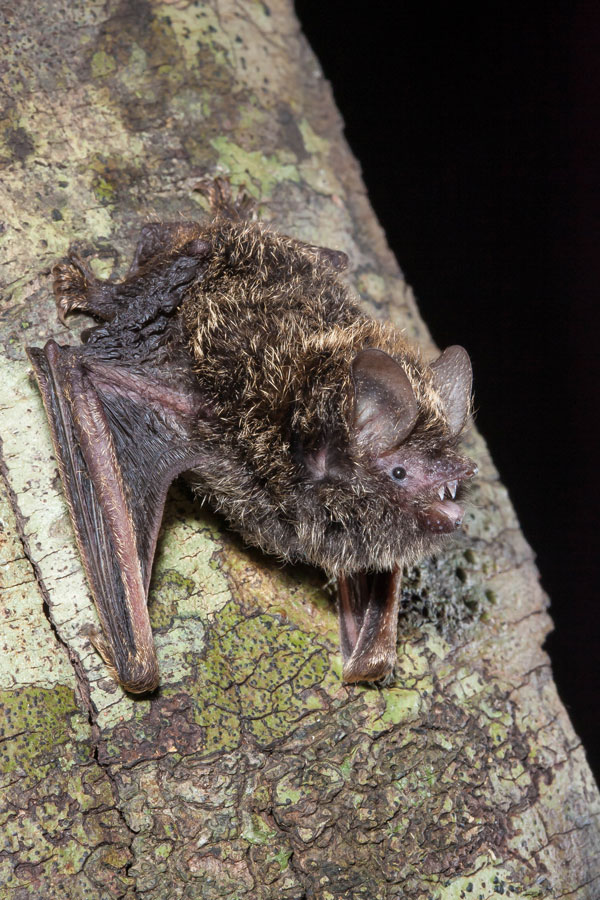The Golden-tipped Bat (Kerivoula papuensis) is a relatively unknown species. Until the 1980s it was thought to be extinct, however it is now found in low numbers across several locations. Currently these special bats are found in New Guinea and in Australia from Cape York to southern NSW. There are only two con rmed sightings of these bats in the Lockyer Valley. There is a growing understanding of the relationships that these bats have with vegetation types, understorey density, food and roosting requirements.
Golden-tipped Bats primarily eat orb- weaving spiders along with smaller quantities of beetles, moths, butterflies and flies. Surveys undertaken in the Richmond Range in northern NSW found that 90% of their diet was spiders. The abundance of food sources, particularly spiders, was found to be related to the density and health of understorey vegetation.
These bats have been recorded flying up to 2km from roosting sites to forage for food. Foraging occurs in rainforest, but is mainly con ned to the upper slopes of sclerophyll forests. Golden-tipped Bats have the ability to y slowly and hover, assisting them through thick vegetation whilst foraging.

Photo by Dr Bruce Thomson
Golden-tipped Bats primarily roost along rainforest gullies of small ( first and second order) waterways, which are located close to wet and dry sclerophyll forests up to 1000m. They are noted to have multiple roosts and regularly change roosts. Roosting can occur as individuals or in small colonies (less than 20 individuals), either with a mix of male and females or just one gender.
A fascinating aspect of these bats is that they utilise the abandoned nests of Yellow-throated Scrubwrens and Brown Gerygones for roosting. Golden-tipped Bats modify the underside of these nests for access. They are also noted to roost under thick moss on the underside of trees, in dense foliage, tree hollows and in epiphytes. Unsurprisingly, Yellow-throated Scrubwrens and Brown Gerygones generally build their nests along first and second order streams within rainforests.
Golden-tipped Bats breed once a year and maternity roosts may occur away from water sources. These maternity roosts have again been recorded as using both the Brown Gerygone and Yellow-throated Scrubwren nests as well as tree hollows.
Threats to these amazing mammals include clearing and burning of riparian rainforest, clearing and modification of the understorey in sclerophyll forests, loss of connectivity between roosting and foraging habitat, and the loss of hollow- bearing trees.
We can assist these special bats by maintaining rainforest and sclerophyll forests along gullies, retaining dense understorey on sclerophyll slopes, maintaining linkages between roosting and foraging habitat, protecting hollow-bearing trees and excluding fire from rainforest. The identified inter- relationship between Golden-tipped Bats, Brown Gerygones and Yellow-throated Scrubwrens also indicate that healthy habitats for small rainforest birds will have a positive effect upon Golden-tipped Bats.
Once again the natural world highlights that inter-relationships are integral to life on Earth. We glimpse through the Golden- tipped Bat the inter-relationships between plants and animals in surprising and relatively unknown ways.
References
Australian MuseumAustralian WildlifeDepartment of Environment and Heritage QldDepartment of Environment NSW
Law BS & Chidel M (2004) Roosting and foraging ecology of the golden-tipped bat (Kerivoula papuensis) on the south coast of New South Wales. Wildlife Research 31:1.
Schulz M & Wainer J (1997) Diet of the golden-tipped bat Kerivoula papuensis (Microchiroptera) from north-eastern New South Wales, Australia. Journal of Zoology 243:4.

I am wondering if we have a bat living in our roof space, but I only hear evidence of one. However about 4 months ago I detected small ‘squeaks’ when it arrived back about 3am so I wondered if it had bred. It leaves around dusk to 9pm and arrives back around 3 to 6am. We have looked for evidence of entry but hard to detect as our walls are colorbond. I hear it scuffling into the sislation. We have a large block, lots of plants, from shrubs to trees and back onto a native easement of tall spotted gums with some iron barks, wattles and scrub. I have Golden Orb spiders in the season and lots of other spiders. We have a small frog pond plus a couple of small fishponds. We use no garden sprays, but lots of compost, not much commercial fertilizer. I have no object to this little creature sharing the roof space, but wondering if it is a bat, and how I can establish this – only to satisfy my curiosity. Thank you in anticipation of a reply.
Margaret C.
Hi Margaret. There are very few microbats that make a sound audible to human ears, so we are wondering if it is more likely that the animal in your roof is a small rodent or dasyurid (eg. antechinus). To tell what animal it is, you may wish to install a fauna monitoring camera that is motion / heat activated – there are many models on the market or you may be able to borrow one. Alternatively, you may be able to identify the scats near the entrance to your roof. The book, Tracks Scats and Other Traces by Barbara Triggs is excellent at differentiating small scats. The Queensland Museum also provides an excellent Enquiry Service https://www.qm.qld.gov.au/Find+out+about/Ask+an+Expert/Ask+a+Question#.XXX0mCgzZaQ
Cheers.